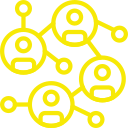BASICS OF TEXTILES
A detailed course, that includes comprehensive course on different types of fabrics, fabric selection, its
properties, and use in Fashion Industry.
PREVIEW THIS COURSE 4.5/5 10540 students enrolled
4.5/5 10540 students enrolled
Created by Indian Design League
ENROLL NOW !!!

ONLINE COURSE
You can watch from Mobile, Laptop or Desktop

LANGUAGE
Hinglish (Comfortable mix of Hindi and English)

WATCH ANYTIME
You can watch anytime as per your comfort.

MANY TIMES
You can watch videos as many times as you want

LIFETIME ACCESS
Lifetime access to the portal which you can use anytime

CERTIFICATE
You will get a certificate on completion of course.

MODULE 1 : INTRODUCTION & OVERVIEW
For all the aspiring and professional Fashion Designers, the course is designed to empower you with various creative, practical, and technical aspects of Fashion Designing. Through this course, you will experience quality learning at its best through lifetime access and value-added resources.

MODULE 2 : INTODUCTION TO TEXTILES
Fabric used in many products - pillow covers, blankets, bedsheets, handbags, apparels, etc. The Indian textile sector is one of the largest industries in the world. Know who are the biggest players in the textile industry and understand the basics to learn about types of fibers, its properties, and remember the process - fiber to yarn and yarns to fabrics.

MODULE 3 : FIBRE CLASSIFICATION.
All textiles are made up of fibers and not all fibers can be used to make textiles. The properties of each fiber varies and thus, it impacts the textile industry accordingly. Learn about classification and origin of different fibers and its identification.

MODULE 4 : COTTON- PROCESSING, PROPERTIES AND USES.
Cotton is one of the most popular and commonly used natural fibers in the world. Cotton is used in many industries and sectors globally like cosmetics, fashion, home furnishings, healthcare, hospitality, etc. Understand the in-depth processes related to manufacturing of cotton, its properties, and its use.

MODULE 5 : LINEN- PROCESSING, PROPERTIES AND USES.
In the modern-day fashion world, Linen is becoming one of the preferred fiber choices for many. It is one of the most commonly used fabrics in the fashion sector. Linen material has advantages and disadvantages of its own. Understand what type of material Linen is, its manufacturing process, its properties, and its common applications.

MODULE 6 : JUTE - PROCESSING, PROPERTIES AND USES.
Due to its properties, Jute is the second most widely used fiber next to cotton and is the most sustainable fabric. It is commonly used to make gunny bags. It is often used to make handbags, carpets, footwear, and other accessories. Know its production process and properties to get a better understanding of how you can use jute in designing.

MODULE 7 : LEAF FIBRES AND ITS TYPES
Have you heard about PINA and ABACA textiles? Fibre can be extracted from fruit plants as well and the fiber is obtained from the leaves of the plant or tree. Most of the leaf fibres are sustainable. Enlighten yourself with the know how of leaf fiber, its origin, popularity, sourcing, processing, properties, attributes, and its uses. Get additional insights on the same.

MODULE 8 : WOOL- PROCESSING, PROPERTIES AND USES.
Did you know, humans have been wearing wool since the stone age. Woolen wear became popular during the First World War. Wool is commonly used to make sweaters, socks, gloves, curtains, and other upholstery. Know about the manufacturing, processing, its properties and uses of the fabric that has been keeping humans warm since ages.

MODULE 9 : SILK - PROCESSING, PROPERTIES AND USES.
Lustrous, elegant, and classy - the three words that perfectly define the silk material. This material keeps people wearing it warm in winter and cool in summer. Get some quick fact, check about the fabric which is a natural thermal regulator and know which country is the largest producer and supplier of silk, its origin, processing, its uses, and precautions to prevent damage to this material.

MODULE 10 : MINERALS FIBRE- TYPES, PROCESSING, PROPERTIES AND USES.
Mineral fibers are commonly known as non-metallic and inorganic fibers. This video consists in-depth information on two types of mineral fibers - asbestos and glass fiber. While one is a natural fiber another is a man-made fiber. Watch the video to get interesting information on mineral fibers, its processing, its properties, and its applications in different industries.

MODULE 11 : ACRYLIC - MANUFACTURING, PROCESSING AND USES.
Did you know, acrylic fiber is used to make soft toys and warm fur blankets and sweaters!? Dry spinning is a technique used to produce synthetic fibers. Acrylic is another type of synthetic fiber. The video highlights manufacturing process, properties, and common use of acrylic and modacrylic fibers.

MODULE 12 : VISCOSE RAYON- MANUFACTURING, PROPERTIES AND USES.
Viscose is commonly referred to as Rayon. The name Viscose is derived from the way it is manufactured from the viscous organic liquid. Know about popular brands that produce apparels in viscose material. This video includes manufacturing, processing, and its area of uses with more details about viscose rayon.

MODULE 13 : ELASTOMERIC FIBERS-
If you have ever worn or come across the term - stretchable clothes - you probably have used the product of elastomeric fibers. This video explains what elastomeric fibers are, how are they processed, their characteristics, and what is their industrial use.

MODULE 14 : INTRODUCTION TO YARN
Understanding the yarn process makes the foundation of the textile industry. You must have noticed us mention, “Fiber to yarn and yarn to fabrics. Wondering, what exactly is yarn, what is its purpose, how properties of fiber impact the yarn process, what are its types, and how to form yarns? The video covers it all.

MODULE 15 : INTRODUCTION TO BASIC WEAVES
In simple words, weaving is interlacing multiple yarns or threads together into a fabric. Weaving is an important part of the textile industry. All the varieties of cloth and clothing we use today like garments, blankets, pillow covers, curtains, etc. are a result of weaving. Watch the video to know how weaving was started, types of weaving, evolution of weaving, and loads of other interesting information about weaving.

MODULE 16 : TYPES OF FABRICS
Starting from fiber to yarn and from yarn to fabrics, let’s dive into types of fabrics. One of the greatest challenges in the fashion industry is identifying different fabrics with their names. The video provides an overview of types of fabrics and debunks a few myths.

MODULE 17 : POLYESTER AND NYLON- PROCESSING, PROPERTIES AND USES.
Often, when we go shopping, we have heard these terms - polyester and nylon - commonly referred to as the Synthetic Fabrics. So, what exactly is polyester and nylon, how are these two materials made, what is its manufacturing process, what are its properties, and know in which industries is it commonly used - find out for yourself in this video.
WHAT YOU'LL LEARN
ENROLL NOW !!!
WHO IS THIS COURSE FOR ?

-
Anyone Who Wants to Learn Fashion designing
-
Aspiring and professional artists, students, and fashion designers, fashion stylists, fashion managers, fashion merchandisers, and fashion bloggers
-
Enthusiasts who want to pursue a career in different domains of Fashion Design
-
Anyone who wants knowledge about different aspects of Fashion Designing
-
For all entry level to advanced Fashion Designers
COURSE DESCRIPTION
The Basics of Textiles course provides insights on fundamentals of textiles. It helps students get an in-depth understanding of fabric, its types, its classification, its properties, and its industrial application.
There are a variety of materials available in the market today. The use of fabrics depends on the purpose of the event. While cotton is commonly used for casual wear, glossy material is used for party wear. More often than not, it can be really difficult to choose a fabric according to the purpose of deliverables. The valuable insights in this course will guide you through the same.
The course additionally covers the fundamentals of yarn and weaving. The course sheds light on connection between the two, and how the processes are interlinked yet different.
This course will guide you to understand different fabric types, classification of materials, which properties separate one material from the other, colour characteristics, and where and how are these materials used in the industry.
Beginners to intermediate to advanced professionals, being equipped with information on textiles is a must for every fashion designer, stylist, merchandiser, manager, and blogger.
This course is strategically designed to help students gain sound knowledge about the textile industry in an easy-to-understand language and engaging video content.
ENROLL NOW !!!


SABA ANSARI
(Fashion Design- IDL)
“From my experience, I can say Indian Design League is taking every effort so that students can get clarity on key concepts of Fashion Designing.
“I would absolutely recommend this course to anyone who wants to make a career in the fashion industry. Every session is golden and the learning process is way different from traditional one. A thumbs-up to IDL.”
I am really happy that I found the IDL platform during the challenging period of the lockdown and I can’t thank them enough for the very detailed modules.”

SHREYA PATIL
(Fashion Design - IDL)
“I was always curious about IDL Platform. When I got to know that along with the course, IDL organises webinars that give us industry insights, I was overjoyed. The course prepared me for a career for life and I’m already approaching big clients. So, along with learning fashion designing, I am also able to develop my personality. I am so grateful to be a part of the IDL community.”

MANALI SHELKE
(Fashion Design - IDL)
“First of all, I am very thankful to IDL & Chandrakant sir for having created a new platform for us students. I am very grateful of IDL. I am enjoying this journey in a very positive & energetic way. Today, I realized we have to start our professional life, and for that we should be active & be ready to face any challenge. Thank you so much IDL for this wonderful course.”

APARNA AGRAWAL
(Fashion Design - IDL)
“My learning experience with IDL is one of the best times, especially when lockdown hit us. I was waiting for a right opportunity to explore my talent and skip conventional career choices. IDL was like an answer to my prayers. It taught me Fashion Design with such precision and perfection that today, I am an accomplished self-employed designer. IDL has given a definite direction to my life. I would like to thank IDL for all the commendable efforts.
